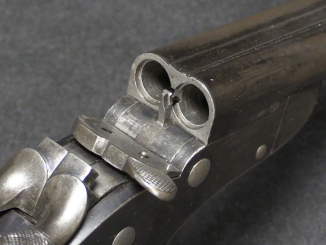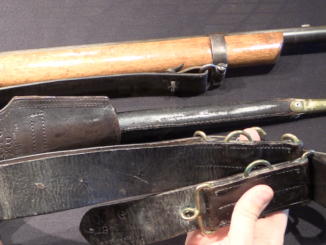By the time Bergmann found a production subcontractor in AEP for the Spanish order of 1903 Bergmann pistol, the Spanish had added a few new changes to their order, which became known as the Model 1908. In addition to filling the Spanish production, AEP also sold the guns on the commercial market fairly successfully, under their Bayard trademark.
In 1910 an order was placed by the Danish government, with a few additional changes to the design (improved mainspring, magazine well cutouts to better grip the magazines, larger grips, etc) which became the Model 1910. AEP would institute these changes into their commercial guns as well as producing 4800 for Denmark. Production continued for civilian sales during German occupation in World War One, but ended after the war due to a lack of demand.
When Denmark began to run low of spare parts and wanted more pistols in 1921, they made yet more changes (primarily a much better set of grips and a non-reversible locking block to simplify reassembly) and put the new Model 1910/21 into production domestically. These would be the highest production evolution of the design, and are very nice sidearms, despite being bulky, heavy, poorly balanced, and low capacity in comparison to the other handguns then available on the market.




I have always found it very curious that both the Spanish and the Danish militaries wanted their Bergmanns with 6 round magazines. Did they consider longer magazines too bulky or perhaps they thought that loading a a smaller capacity mag with a stripper clip would be more practical?
In any case and all things considered, I would probably prefer a good revolver in .38 Special, such as the S&W Model 10, over this semi-auto with a 6 shot magazine, despite the .38 Special’s somewhat lower muzzle energy.
I’ve come to believe that it’s just human nature — people come to accept certain things and tend to stubbornly resist change as much as possible. So just about any kind of revolutionary new product needs to be dialed back a few steps in order to maintain more consistency with the way people had been used to doing things in the past. I could probably fill a book with examples that I’ve seen, but I’ll name just one. In the late 1980s and early 1990s, when U.S. police forces started replacing their service revolvers with semi-automatic pistols, they demanded double-action with heavy trigger pull, presumably in order to mimic the revolver experience as much as possible.
Likewise, the Bergmann’s six shot magazine capacity was probably not a coincidence.
Perhaps the officers were expected to easily transition from revolver to semi automatic pistol and keep some form of familiarity as not to throw off old reloading habits. And having a ten round detachable magazine would require a new form of holster. A six shot revolver with a good reload speed and a six shot Bergmann with clip loading would have sufficed for anyone not assigned to actual combat duty. Did I mess up?
“Did they consider longer magazines too bulky or perhaps they thought that loading a a smaller capacity mag with a stripper clip would be more practical?”
Longer magazine would make balance even more “muzzle-heavy” and also they might fear it will perform poorly reliability-wise.
“Danish militaries wanted their Bergmanns with 6 round magazines”
Zhuk lists Bergmann 1910/21 capacity as 6 or 10 without any further information.
“very curious that both the Spanish and the Danish militaries wanted their Bergmanns with 6 round magazines”
6 might looks low from modern standpoint, but in 1910s?
Sweden (nearby Denmark) used Husqvarna m/1907 with capacity 7.
It’s true that there isn’t much difference between 6 and 7 rounds, but even 7 rounds was lower than most military semi-auto pistols at the time, except the 1911, which was chambered for a lot bigger cartridge. The Campo-Giro, which replaced the Bergmann in Spain, also had an 8 round magazine. If a 10 round magazine was too bulky and ruined the balance, then why not request an 8 round magazine? I am sure Bergmann and Pieper would have been more than happy to comply. But apparently the Danes were happy with six shots, since even their domestic production was mostly if not entirely with 6 round magazines.
Hærens Tøjhus actually means Armys Arsenal. I’m Norwegian so I wasn’t sure about the word Tøjhus as it isn’t one we use, but I visited their museum not long ago. http://en.natmus.dk/museums/the-royal-danish-arsenal-museum/exhibitions-at-the-royal-danish-arsenal-museum/
The relatively heavy double action triggers were as much about liability as anything else. Police pistols are carried much but used seldom. That’s still true dispite recent publicity. The reasons given for adoption were the hopes of reducing possible ADs and unnecessary shootings.
I’ve always wanted one of these since I first read about them 30 years ago but since I don’t make a phone number that will never happen.
Would that have been in Guns & Ammo magazine? I first saw this type in a column by Gary James(?).
Interesting how European gun companies shared the workload in ‘unselfish’ manner to satisfy customer’s requirement. Kind of “work-share” by today’s terminology.
I like the displayed weapons in sense of what they are and the presentation – splendid as always.
Note that in that time (1910) Belgium was European centre (or center? I am not sure what word is proper here) for automatic pistols.
Also it seems that in 1910, civil market rather don’t shows NOT INVENTED HERE syndrome
I don’t think anyone cares whether you write American or British English on Internet forums. The danger of misunderstandings is quite small.
Luttich also known as Liege was center of excellence for firearms some 2 centuries earlier. I have book on 100years anniversary of FN, plenty of reference there.
Historical splendour of city is clearly visible from Palais Provincial in Liege, Wallonie.
https://cs.wikipedia.org/wiki/Lutych#/media/File:Palais_provincial,_Li%C3%A8ge.jpg
“Luttich also known as Liege”
I, most common, encounter name of that in form of Liège (with e grave)
Could that little stud on the back of the bolts of the Danish contract guns also serve as an out of battery safety? Meaning, if the bolt wasn’t far enough forward the hammer would hit the stud instead of the firing pin…
The Danish 2015 movie “9. april” offers some nice views of a model 1910/21 and its holster as well as Madsen 8 mm machine guns and a couple of different versions of the Krag-Jørgensen M.89 carbines.